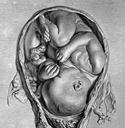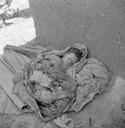This article was featured previously in our issue on Fatherhood (Winter 2012/13).
Life Is a Blessing recounts, largely in vignettes, the life of Dr. Jerome Lejeune as seen through the eyes of his daughter Clara. A great depth underlies her seemingly simple narrative of his life in three arenas: geneticist, doctor, and father. She asks with some sorrow, “Why should we call to be our witnesses strangers who will never know with what love he loved us? Why confess to them that we will never really know it ourselves, since love is so mysterious, obscure, and painful, even in its own domain?” (p. 112). Her labor in undertaking the task nonetheless is a real blessing for readers who have the grace to encounter a man whose extraordinary fruitfulness flowed from a certainty of being loved.
Jerome and his wife Birthe created a home characterized by “hospitality without limits,” experienced by his children and the constant stream of guests. For the former, it was the foundation of a positive sense of self: “The child who sees that his parents love each other understands everything…. He is there because his parents loved each other one day, one night, thus bringing about the miracle of life. He is happy because his parents still love each other. He is happy because his parents are happy that he is there, a witness to their love” (pp. 1-2).
For Jerome, hospitality was born of his own experience of being deeply loved, so the awareness that life is a blessing blossomed from his earliest days. From his diary, we learn that his father rejoiced on his deathbed that he and Jerome “had lived together without ever a [harsh] word between us,” and Jerome describes the happiness he enjoyed with his father as “one of the most beautiful gifts Providence has given me” (pp. 130, 136). In short, the paternity he lived toward his children and his patients can be outlined thus: father, because first son. With such a powerful example of paternity, it is not surprising that Jerome joyfully embraced the Fatherhood of God and passed on to his five children “what he considered the most precious gift that a father can give his children: the gift of knowing that they are loved, infinitely loved, by the God of the living” (p. 108).
Their parents introduced Jerome and his two brothers to beauty, immersing them in literature, music (his mother was a musician), and art (his brothers became artists). “As adults, they considered that what their parents had given them was beautiful and good. They cultivated it without contesting it” (p. 84). Jerome, though a doctor, because of his upbringing, looked at the world with an artist’s eye and filled his lectures and writings with metaphors to make them more easily grasped, often using images drawn from his Sunday walks in the countryside.
Between this emphasis on beauty and the perception of life as gift, Jerome’s life and work was infused with a sense of wonder. Man alone among the creatures has the capacity for wonder, as he told his children: “admiring a sunset, contemplating beauty, being aware of the Infinite, and hence being able to reason about the human condition – only man has that grace” (p. 16). Wonder and curiosity constantly reinforced each other and led to knowledge: “Understanding the human body, its subtle mechanisms, the origin of life – for him it was an object of study, but also of unending wonder. What a marvelously ingenious and complex machine is this body that makes us live!” (p. 24). One of Dr. Lejeune’s early discoveries (in 1959) was the presence in persons with Downs syndrome of a third chromosome on the 21st pair, a genetic anomaly he called trisomy 21. In a cultural context in which children with this disorder were often believed to be the consequence of moral depravity in the mother, his finding gave dignity to people he called “the disinherited.” Thirty-five years later, at Dr. Lejeune’s funeral, a man who was one of the seven whose karyotype led to the discovery of trisomy 21 stepped unbidden to the microphone to make the following tribute: “Merci, mon professeur, for what you did for my father and my mother. Because of you, I am proud of myself” (p. 123). Later, Dr. Lejeune went on to find the genetic causes of cri-du-chat, monosomy 9, trisomy 13, and other rare diseases. He also made a breakthrough regarding the prenatal use of folic acid to prevent spina bifida. He accompanied countless parents in embracing their genetically handicapped children: “[After the appointment,] we left with our baby, all of us much calmer. He helped us to discover our love as parents” (p. 27).
In his passionate desire to improve the lives of the “disinherited,” Dr. Lejeune spent the remainder of his life searching for a cure for trisomy 21; he believed a cure for this most prevalent of genetic intellectual disorders (1 in 750 births) would pave the way for the cure of the less common ones. He gave unstintingly of his time to his patients, their parents, his research, the training of a whole generation of French geneticists, participating in international conferences, and serving as a scientific advisor to numerous governments. Much recognition and many prestigious prizes came his way, but he continued to live a completely unpretentious lifestyle, e.g. wearing the same suits for decades and riding his bicycle to and from work daily. He renounced the opportunity to have “power lunches,” coming home from the university to eat with his family each afternoon. During the summers, Birthe returned to her native Denmark with the children. Jerome accompanied them on the long drive, but only stayed a few days before returning to Paris to continue his research. He missed his family tremendously, but he did not complain about the painful separation. Each evening, he wrote a letter to Birthe. In fact, for the length of their marriage, they wrote to each other every day they were apart.
It was essential to Dr. Lejeune’s work that he knew himself to be so loved (by God, his parents, wife, children, and patients) because it gave him the strength and courage to continue his work when the praise and approval of the media, colleagues, and the international scientific community turned to scorn and persecution. In San Francisco in 1969 when he went to receive the William Allan Memorial Award from the American Society of Human Genetics, Dr. Lejeune committed career suicide. Understanding that his discovery that allowed persons with trisomy 21 to be identified in utero was going to be used to destroy rather than treat them, he testified as a geneticist about the uniqueness of each child. His speech was received in utter silence. That evening his letter to Birthe anticipated the certain result of his testimony: “This afternoon, I lost my Nobel Prize” (p. 39).
For Clara and her sister, their childhood came to an abrupt end the day they cycled to school past a wall spray-painted “Lejeune and his little monsters must die!” (p. 47). Suddenly, the university deprived Dr. Lejeune of his office space, lab, and funding for research. For the last 15 years of his professional life, funding came from abroad. “He experienced the betrayal of friends, administrative harassment, the condemnation that the modern press can wield…. If he suffered, he never let us see it. In the face of insults, he used to smile, saying, ‘It is not for myself that I’m fighting, so these attacks don’t matter’” (p. 97).
In 1994, John Paul II appointed his friend Dr. Lejeune, then terminally ill, as the first president of the Pontifical Academy of Life. He held the post just over a month until his death on Easter Sunday. For the funeral, the Pope sent a message: “We are faced today with the death of a great Christian of the 20th century, of a man for whom the defense of life became an apostolate.… Prof. Lejeune was always able to employ his profound knowledge of life and of its secrets for the true good of man and of humanity, and only for that purpose” (p. 138). When John Paul II visited Paris in 1997, he prayed at the tomb of his friend, despite the vociferous protests of the French government.
Love, hospitality, wonder, courage, and strength – these all indicate a truly human itinerary. For this reason, in April 2012, a solemn Mass in Notre Dame Cathedral marked the close of the diocesan phase of the cause for canonization of Dr. Jerome Lejeune, and all the pertinent documents were forwarded to the Vatican. So Clara Lejeune-Gaymard’s biography witnesses to a paternity that was not reserved for his family alone but radiated out to the whole world. Perhaps before long, he will be a patron saint for many fathers, doctors, scientists, and above all for the “disinherited.”



